| View previous topic :: View next topic |
| Author |
Message |
Reef
Joined: 13 Dec 2016
Posts: 36


|
 Posted: Oct 22, 2017 06:39 Post subject: Rarest quartz twins with inclined axes C Posted: Oct 22, 2017 06:39 Post subject: Rarest quartz twins with inclined axes C |
|
|
Probably many collectors will be interested in this topic.
Tiflis law twin
| Mineral: | Quartz |
| Locality: | | Orenburgskaya Oblast, Southern Urals, Urals Region, Russia |  |
|
| Dimensions: | 16x13mm |
| Description: |
| I apologize for the poor picture quality. |
|
| Viewed: |
35961 Time(s) |
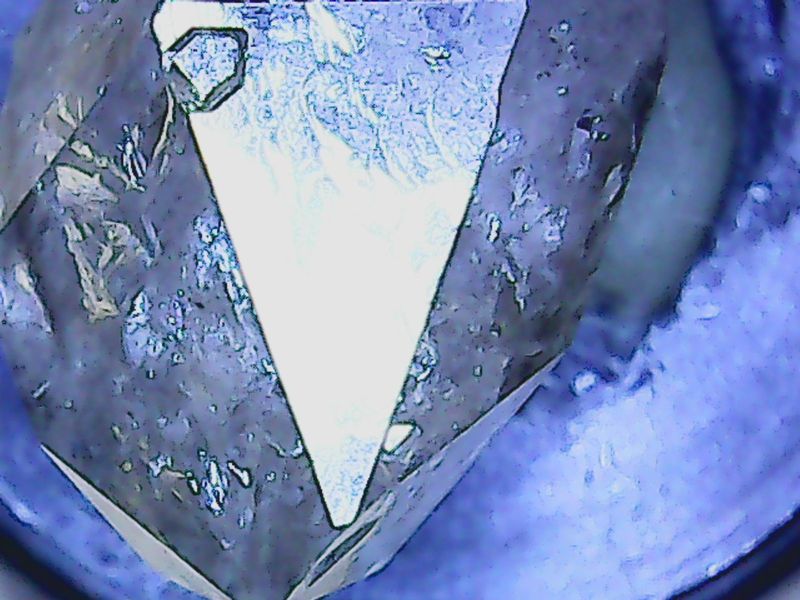
|
| Mineral: | Tiflis law twin |
| Description: |
Schematic drawing
Green lines show parallel edges (zone vectors). Crosses are parallel faces. |
|
| Viewed: |
35941 Time(s) |
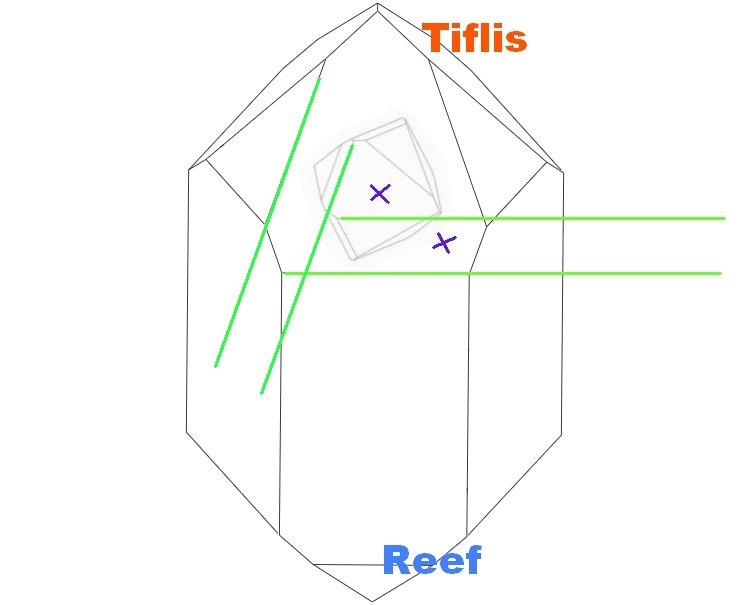
|
|
|
| Back to top |
|
 |
Reef
Joined: 13 Dec 2016
Posts: 36


|
 Posted: Oct 22, 2017 07:52 Post subject: Re: Rarest quartz twins with inclined axes C Posted: Oct 22, 2017 07:52 Post subject: Re: Rarest quartz twins with inclined axes C |
|
|
Zyndel A law twin
| Mineral: | Zyndel A law twin |
| Description: |
Schematic drawing
Green lines show parallel edges (zone vectors). Crosses are parallel faces. |
|
| Viewed: |
35996 Time(s) |
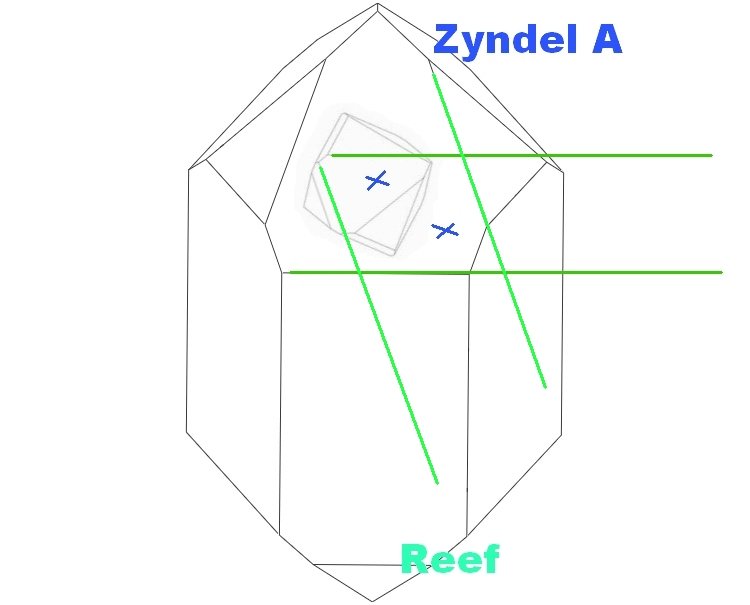
|
| Mineral: | Quartz |
| Locality: | | Orenburgskaya Oblast, Southern Urals, Urals Region, Russia |  |
|
| Dimensions: | 9x5mm |
| Description: |
|
| Viewed: |
35927 Time(s) |
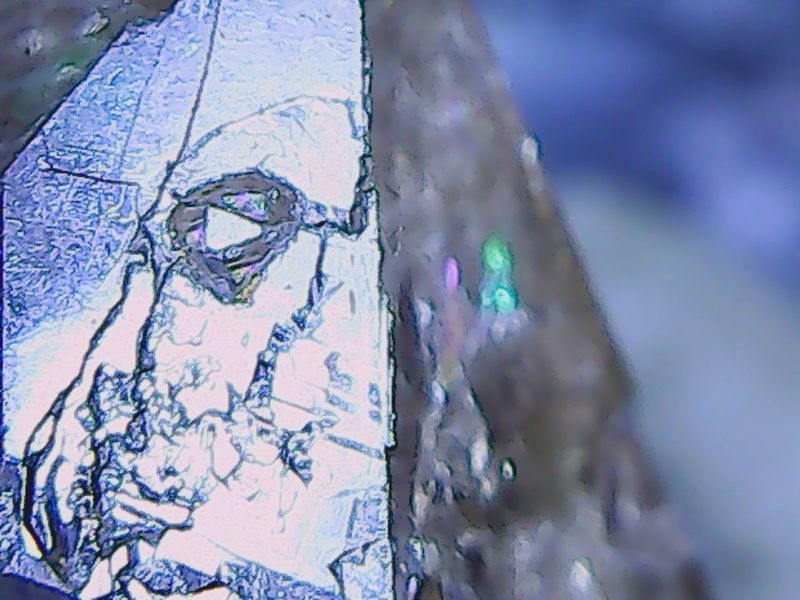
|
|
|
| Back to top |
|
 |
Reef
Joined: 13 Dec 2016
Posts: 36


|
 Posted: Oct 22, 2017 08:06 Post subject: Re: Rarest quartz twins with inclined axes C Posted: Oct 22, 2017 08:06 Post subject: Re: Rarest quartz twins with inclined axes C |
|
|
Sella Law Twin
| Mineral: | Sella Law Twin |
| Description: |
Sella Law Twin
Schematic drawing
Blue lines show parallel edges (zone vectors). Crosses are parallel faces. |
|
| Viewed: |
35971 Time(s) |
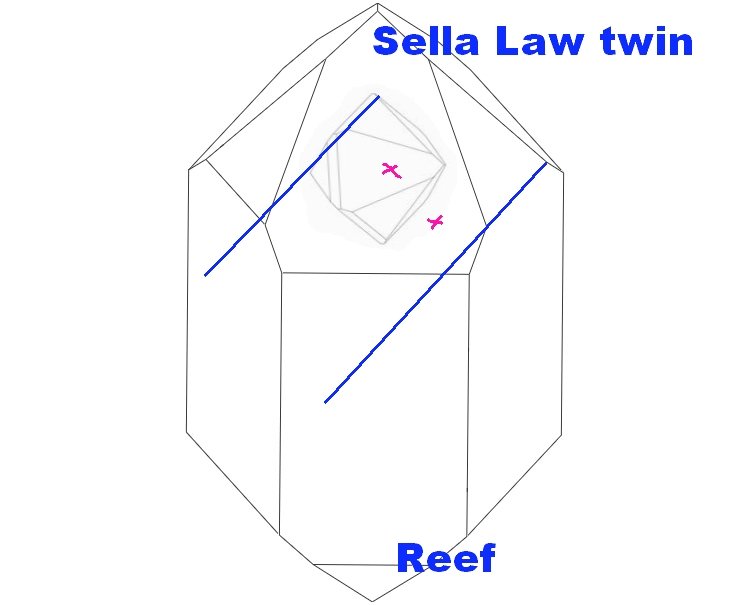
|
| Mineral: | Quartz |
| Locality: | | Orenburgskaya Oblast, Southern Urals, Urals Region, Russia |  |
|
| Dimensions: | 18x8mm |
| Description: |
|
| Viewed: |
35960 Time(s) |
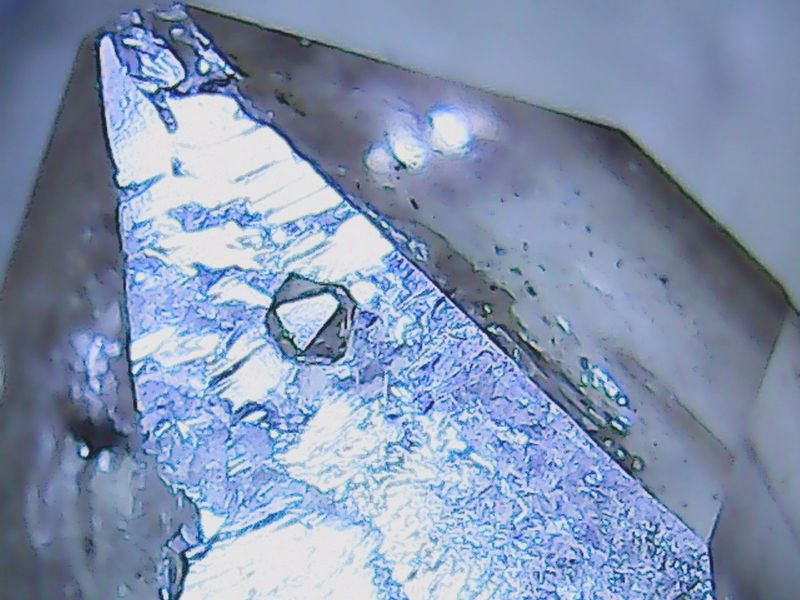
|
|
|
| Back to top |
|
 |
Reef
Joined: 13 Dec 2016
Posts: 36


|
 Posted: Oct 23, 2017 09:55 Post subject: Re: Rarest quartz twins with inclined axes C Posted: Oct 23, 2017 09:55 Post subject: Re: Rarest quartz twins with inclined axes C |
|
|
Zinnwald Law Twin
| Description: |
Schematic drawing
Zinnwald Law Twin
Red lines show parallel edges (zone vectors). Crosses are parallel faces.
1 variant |
|
| Viewed: |
35870 Time(s) |

|
| Description: |
Schematic drawing
Zinnwald Law Twin
Red lines show parallel edges (zone vectors). Crosses are parallel faces.
2 variant |
|
| Viewed: |
35834 Time(s) |
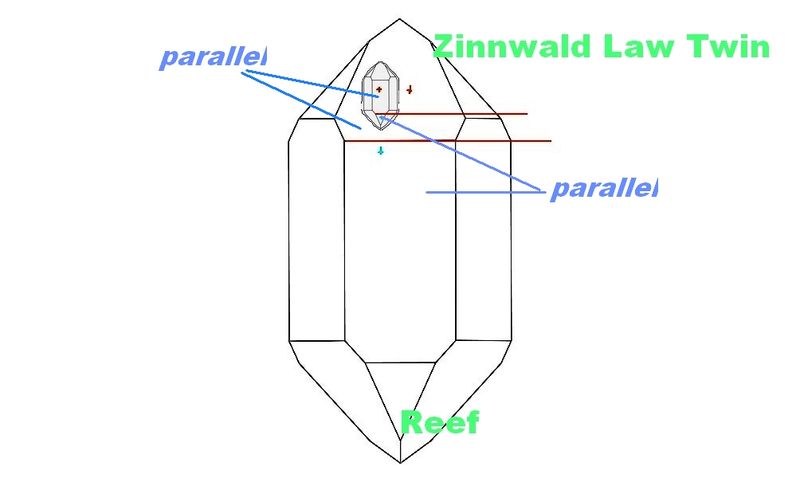
|
| Mineral: | Quartz |
| Locality: | | Orenburgskaya Oblast, Southern Urals, Urals Region, Russia |  |
|
| Dimensions: | 16x8 mm |
| Description: |
|
| Viewed: |
35827 Time(s) |
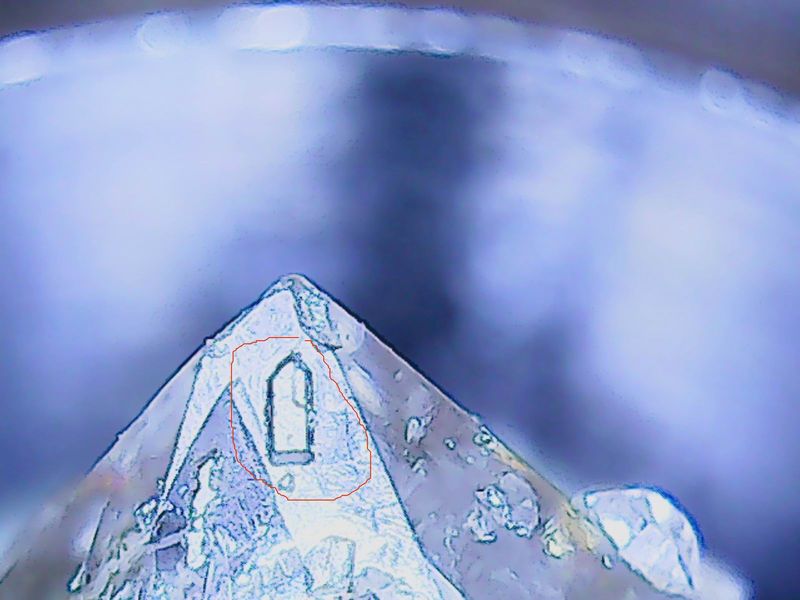
|
| Mineral: | Quartz |
| Locality: | | Orenburgskaya Oblast, Southern Urals, Urals Region, Russia |  |
|
| Dimensions: | 16x8 mm |
| Description: |
| Zinnwald Law TwinAnother perspective |
|
| Viewed: |
35798 Time(s) |
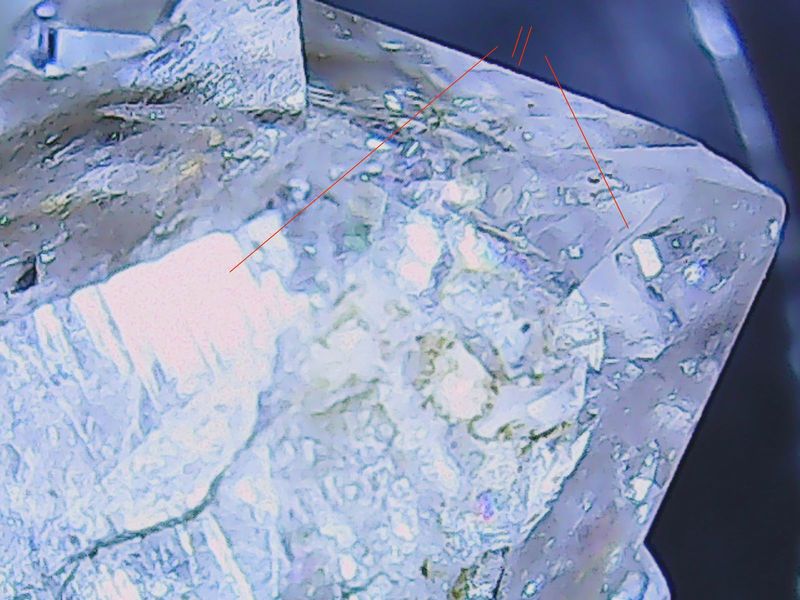
|
|
|
| Back to top |
|
 |
Reef
Joined: 13 Dec 2016
Posts: 36


|
 Posted: Oct 23, 2017 10:46 Post subject: Re: Rarest quartz twins with inclined axes C Posted: Oct 23, 2017 10:46 Post subject: Re: Rarest quartz twins with inclined axes C |
|
|
Lötschental law twin
| Mineral: | Lötschental law twin |
| Description: |
Schematic drawing
Lötschental law twin
Lines show parallel edges (zone vectors). Crosses are parallel faces.
1 variant |
|
| Viewed: |
35803 Time(s) |
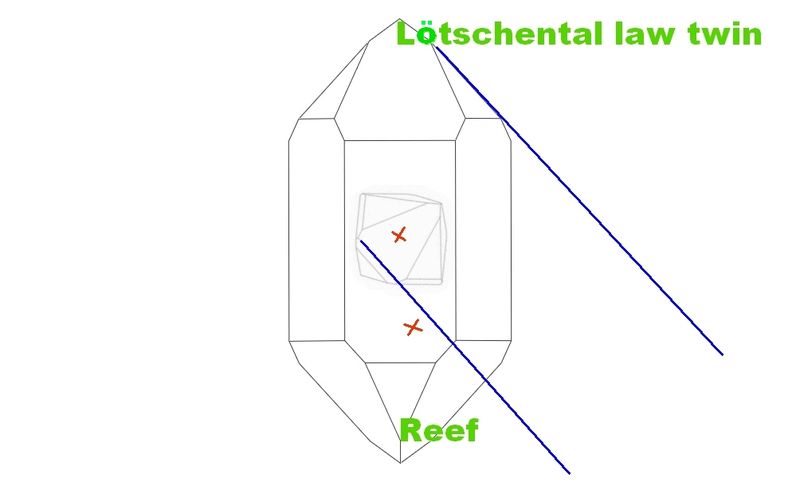
|
| Mineral: | Lötschental law twin |
| Description: |
Schematic drawing
Lötschental law twin
Lines show parallel edges (zone vectors). Crosses are parallel faces.
2 variant |
|
| Viewed: |
35771 Time(s) |
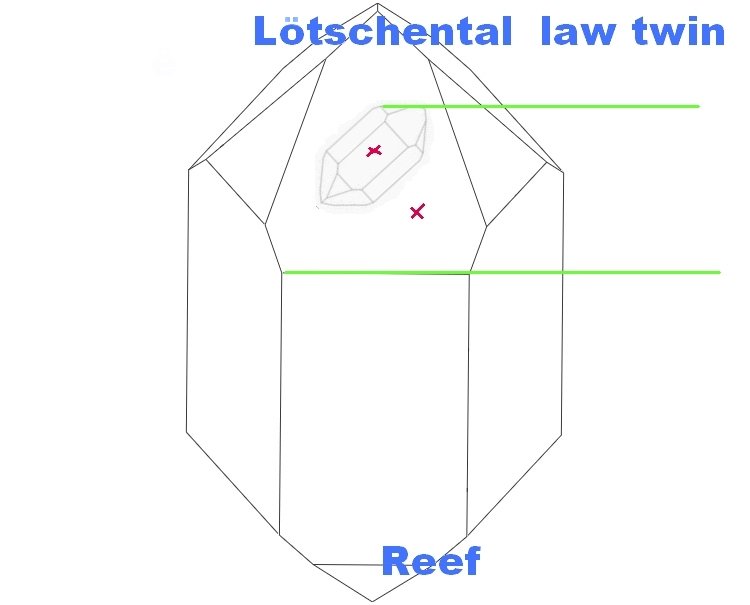
|
|
|
| Back to top |
|
 |
Reef
Joined: 13 Dec 2016
Posts: 36


|
 Posted: Oct 23, 2017 11:20 Post subject: Re: Rarest quartz twins with inclined axes C Posted: Oct 23, 2017 11:20 Post subject: Re: Rarest quartz twins with inclined axes C |
|
|
Zyndel L law twin
| Description: |
Schematic drawing
Zyndel L law twin
Red lines show parallel edges (zone vectors). Crosses are parallel faces.
1 variant |
|
| Viewed: |
35754 Time(s) |
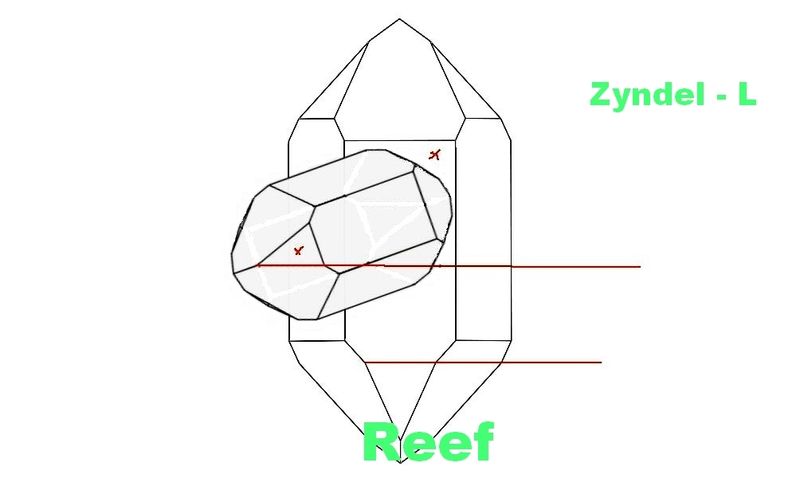
|
| Description: |
Schematic drawing
Zyndel L law twin
Red lines show parallel edges (zone vectors). Crosses are parallel faces.
2 variant |
|
| Viewed: |
35829 Time(s) |
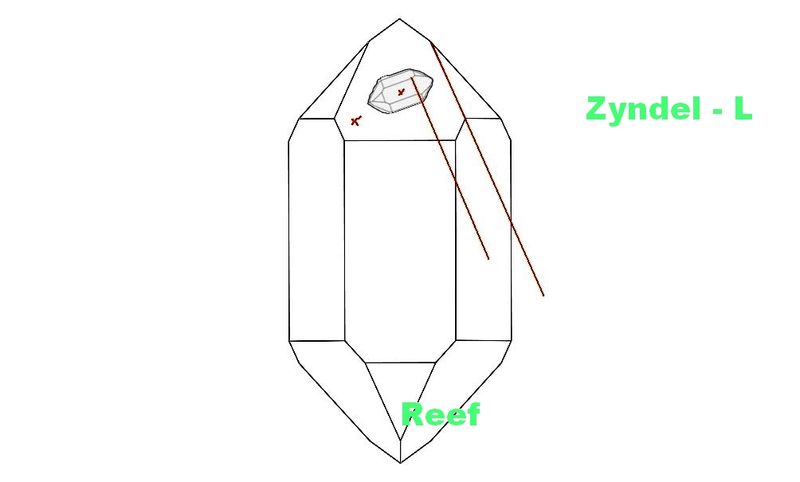
|
| Mineral: | Quartz |
| Locality: | | Orenburgskaya Oblast, Southern Urals, Urals Region, Russia |  |
|
| Dimensions: | 18x9 mm |
| Description: |
|
| Viewed: |
35757 Time(s) |
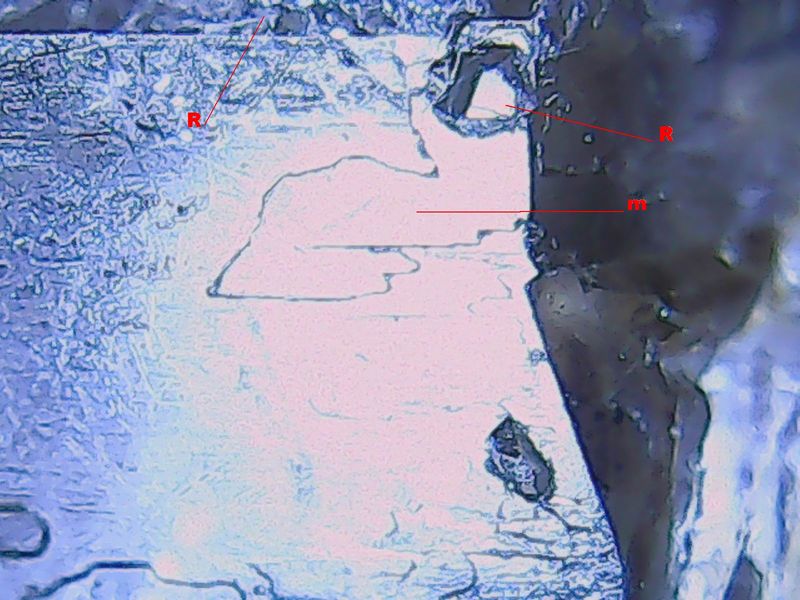
|
|
|
| Back to top |
|
 |
marco campos-venuti

Joined: 09 Apr 2014
Posts: 234
Location: Sevilla



|
 Posted: Oct 23, 2017 13:05 Post subject: Re: Rarest quartz twins with inclined axes C Posted: Oct 23, 2017 13:05 Post subject: Re: Rarest quartz twins with inclined axes C |
|
|
Hi, I have a strange group of crystals of irradiated quartz from Arkansas.
The crystal A lays on the matrix. The crystal B grows from a rhombohedron face of crystal A. A and B crystals share a plane of symmetry having two faces of the prism with same orientation in both crystals. B has the C axis rotated of around 50 degrees.
Rhombohedron z of crystal A is parallel to prism of crystal B.
Do you think it is a twinning?
In the same group there is another crystal with two flat crystals above two prism faces with rotation of c axis (last picture shows one of them). Which law is it?
marco
| Mineral: | Quartz |
| Locality: | | Arkansas, USA |  |
|
| Dimensions: | 11 cm |
| Description: |
|
| Viewed: |
35734 Time(s) |
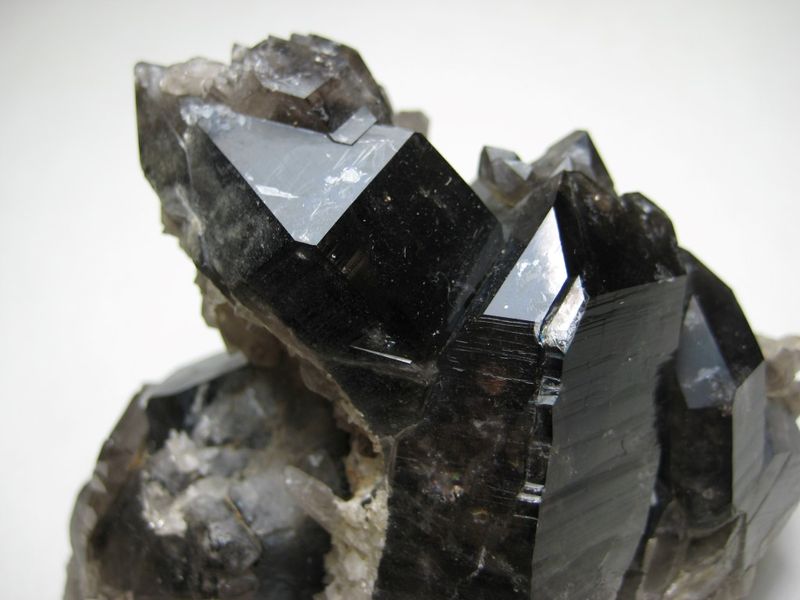
|
| Mineral: | Quartz |
| Locality: | | Arkansas, USA |  |
|
| Dimensions: | 11 cm |
| Description: |
|
| Viewed: |
35706 Time(s) |
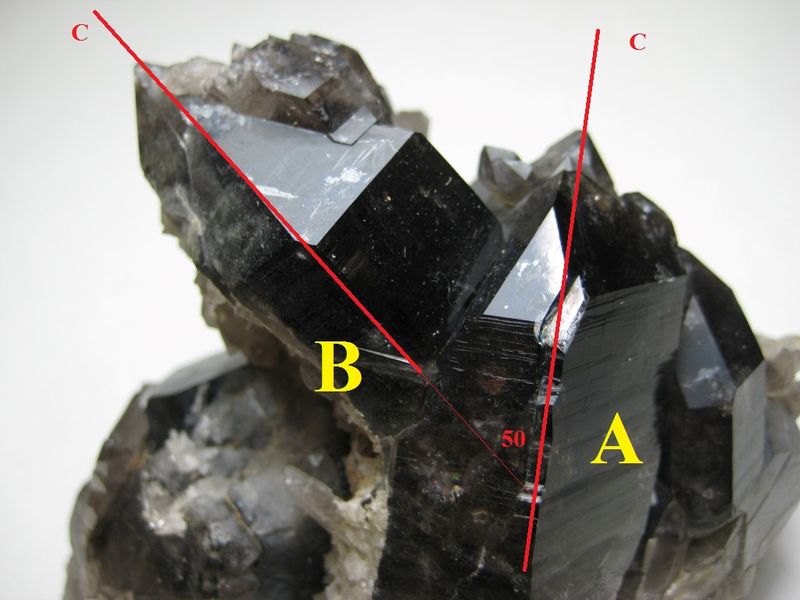
|
| Mineral: | Quartz |
| Locality: | | Arkansas, USA |  |
|
| Dimensions: | 11 cm |
| Description: |
|
| Viewed: |
35723 Time(s) |
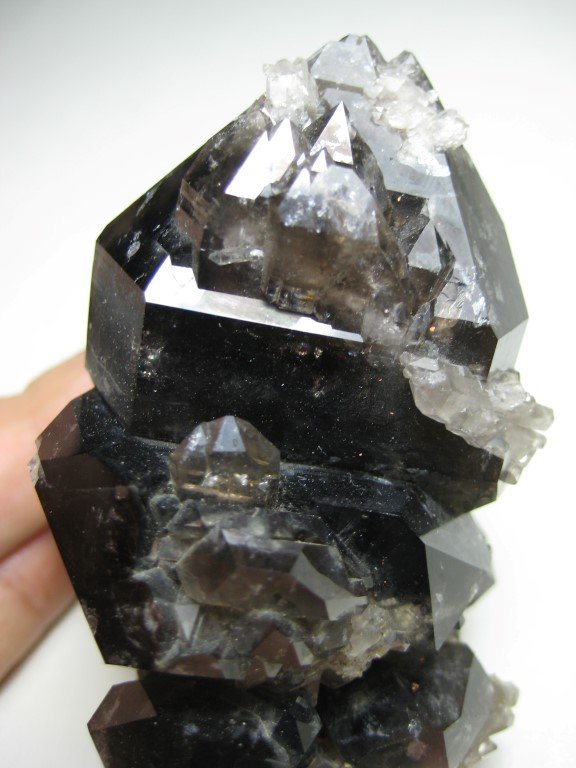
|
| Mineral: | Quartz |
| Locality: | | Arkansas, USA |  |
|
| Dimensions: | 11 cm |
| Description: |
|
| Viewed: |
35720 Time(s) |
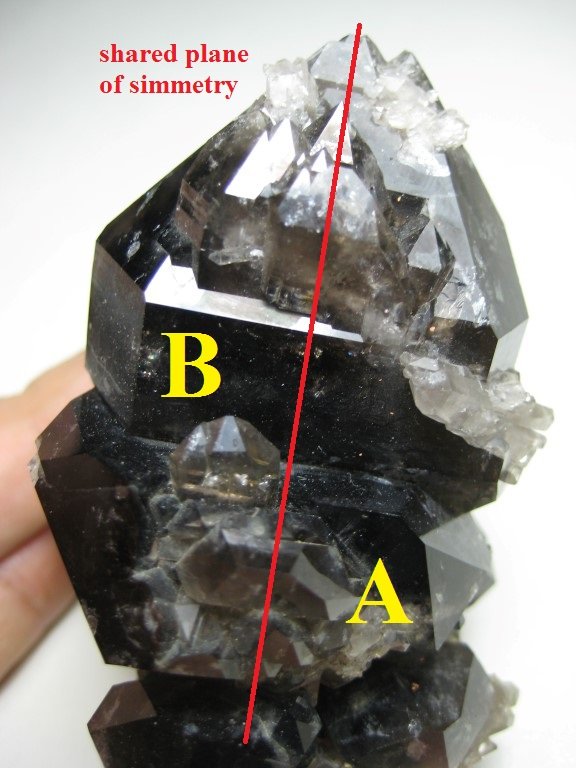
|
| Mineral: | Quartz |
| Locality: | | Arkansas, USA |  |
|
| Dimensions: | 11 cm |
| Description: |
|
| Viewed: |
35752 Time(s) |

|
|
|
| Back to top |
|
 |
Reef
Joined: 13 Dec 2016
Posts: 36


|
 Posted: Oct 23, 2017 14:10 Post subject: Re: Rarest quartz twins with inclined axes C Posted: Oct 23, 2017 14:10 Post subject: Re: Rarest quartz twins with inclined axes C |
|
|
| Hi! Something does not fit. If the rhombohedra are parallel, then the prisms should not be parallel. Or I not so understood. Please mark the photo with a cross on the parallel faces.
|
|
| Back to top |
|
 |
marco campos-venuti

Joined: 09 Apr 2014
Posts: 234
Location: Sevilla



|
 Posted: Oct 23, 2017 15:39 Post subject: Re: Rarest quartz twins with inclined axes C Posted: Oct 23, 2017 15:39 Post subject: Re: Rarest quartz twins with inclined axes C |
|
|
The prism of both crystals has a face parallel to the picture.
The crystal B is rotated 50 degrees in respect with A, that is the same angle between the prism and the rhombohedron, resulting that the rotated face of the prism of B (not the same face, but one that is perpendicular to the picture) is parallel to the r rhombohedron of the crystal A.
| Description: |
|
| Viewed: |
35730 Time(s) |

|
| Description: |
|
| Viewed: |
35658 Time(s) |
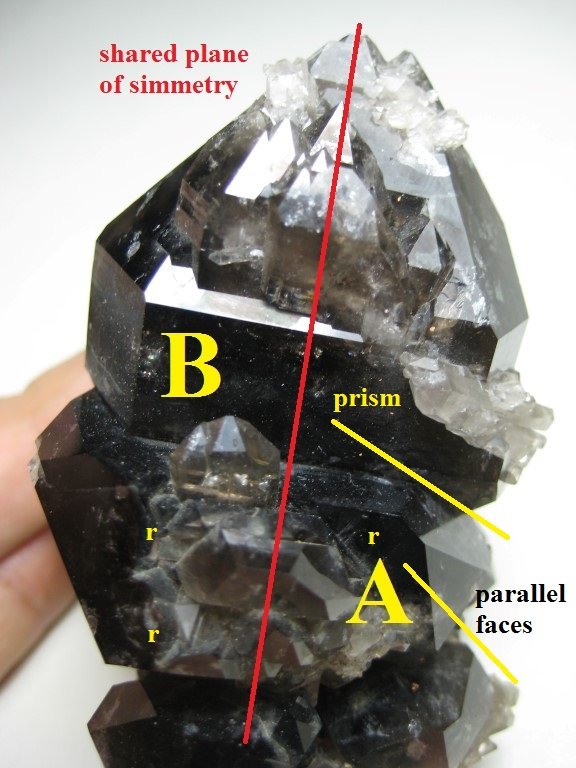
|
|
|
| Back to top |
|
 |
Reef
Joined: 13 Dec 2016
Posts: 36


|
 Posted: Oct 25, 2017 11:32 Post subject: Re: Rarest quartz twins with inclined axes C Posted: Oct 25, 2017 11:32 Post subject: Re: Rarest quartz twins with inclined axes C |
|
|
Seedorf 2 law twin
| Mineral: | Seedorf 2 law twin |
| Description: |
Seedorf 2 law twin
Schematic drawing
Lines show parallel edges (zone vectors). Crosses are parallel faces.
Variant 1 |
|
| Viewed: |
35465 Time(s) |
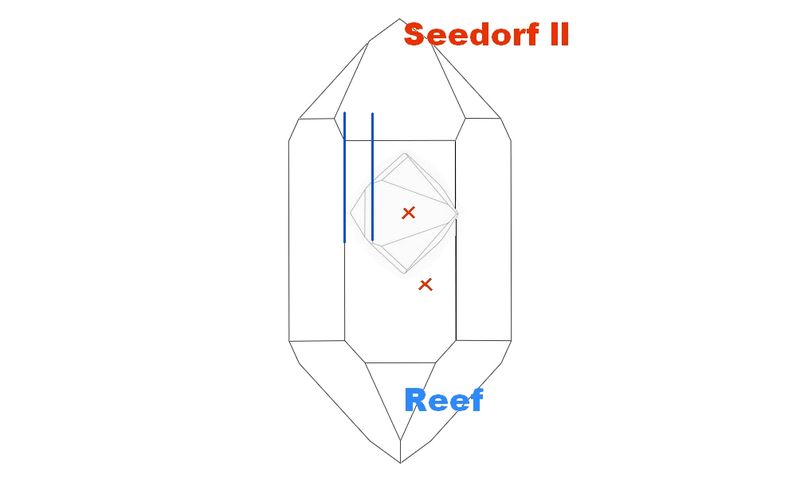
|
| Mineral: | Seedorf 2 law twin |
| Description: |
Seedorf 2 law twin
Schematic drawing
Lines show parallel edges (zone vectors). Crosses are parallel faces.
Variant 2 |
|
| Viewed: |
35458 Time(s) |
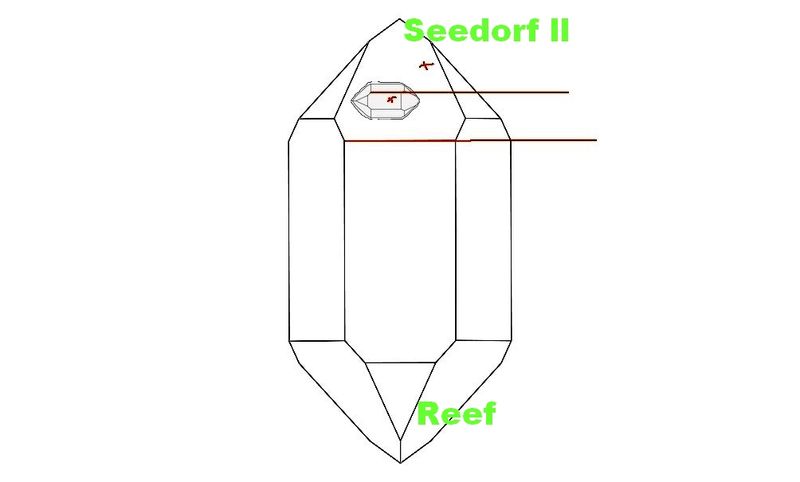
|
| Mineral: | Quartz |
| Locality: | | Orenburgskaya Oblast, Southern Urals, Urals Region, Russia |  |
|
| Dimensions: | 11x8 mm |
| Description: |
|
| Viewed: |
35457 Time(s) |
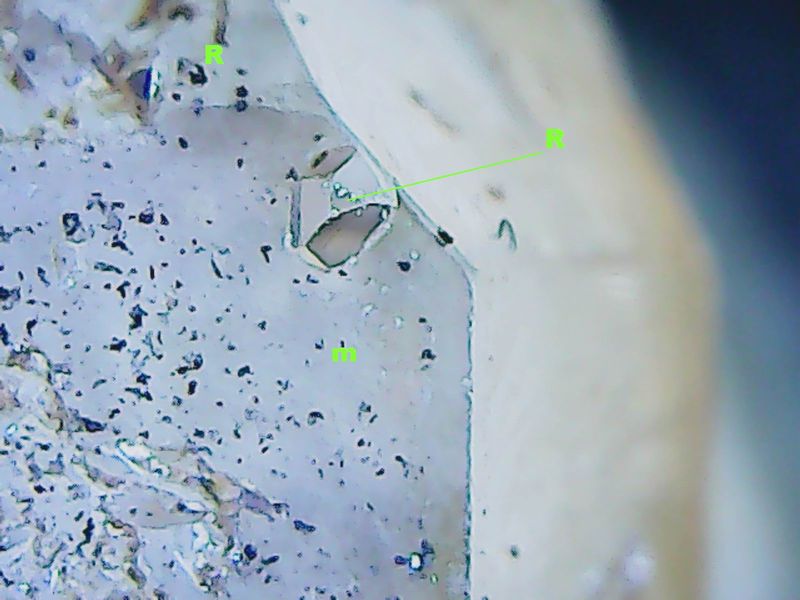
|
|
|
| Back to top |
|
 |
Reef
Joined: 13 Dec 2016
Posts: 36


|
 Posted: Oct 25, 2017 11:55 Post subject: Re: Rarest quartz twins with inclined axes C Posted: Oct 25, 2017 11:55 Post subject: Re: Rarest quartz twins with inclined axes C |
|
|
Seedorf 1 law twin
| Mineral: | Seedorf 1 law twin |
| Description: |
Schematic drawing
Seedorf 1 law twin
Red lines show parallel edges (zone vectors). Crosses are parallel faces.
Variant 1 |
|
| Viewed: |
35409 Time(s) |
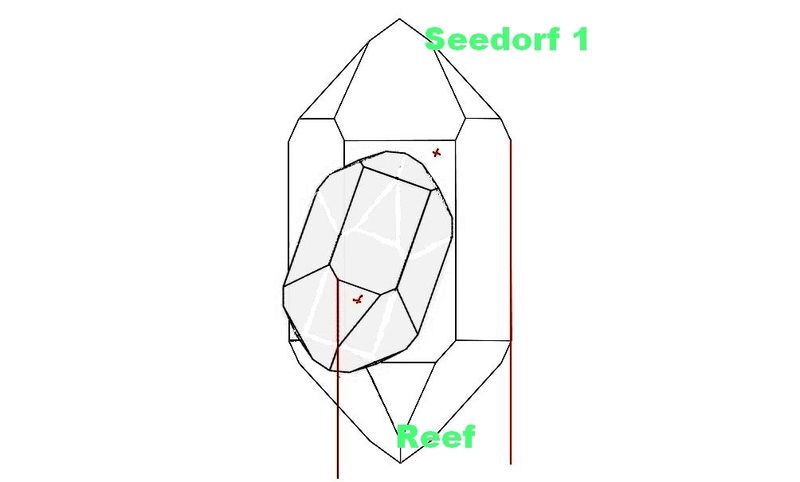
|
| Mineral: | Seedorf 1 law twin |
| Description: |
Schematic drawing
Seedorf 1 law twin
Red lines show parallel edges (zone vectors). Crosses are parallel faces.
Variant 2 |
|
| Viewed: |
35372 Time(s) |
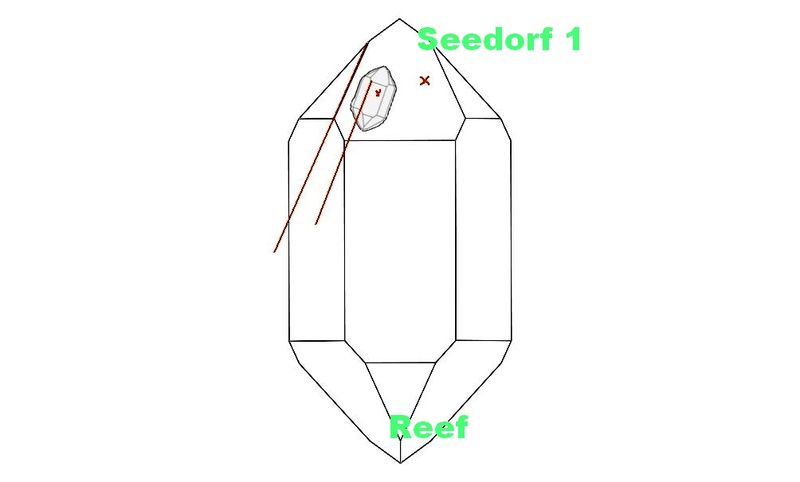
|
| Mineral: | Quartz |
| Locality: | | Orenburgskaya Oblast, Southern Urals, Urals Region, Russia |  |
|
| Dimensions: | 13x4 mm |
| Description: |
|
| Viewed: |
35426 Time(s) |
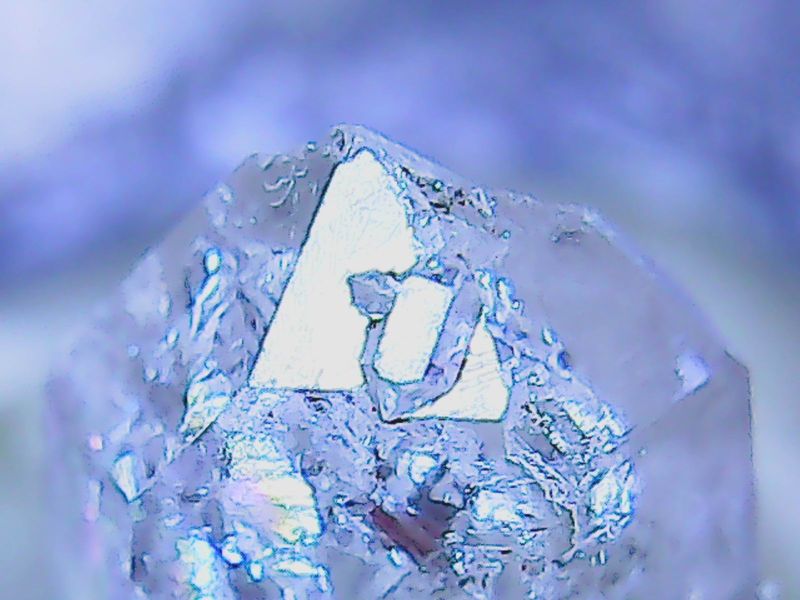
|
|
|
| Back to top |
|
 |
Josele

Joined: 10 Apr 2012
Posts: 410
Location: Tarifa, Spain



|
 Posted: Oct 25, 2017 15:56 Post subject: Re: Rarest quartz twins with inclined axes C Posted: Oct 25, 2017 15:56 Post subject: Re: Rarest quartz twins with inclined axes C |
|
|
Reef, sorry for my ignorance, I have not heard about these quartz twins before. They really fit the Twin definition by the International Union of Crystallography?
Which are the twin operations?
Thanks for explanation.
_________________
Josele |
|
| Back to top |
|
 |
Josele

Joined: 10 Apr 2012
Posts: 410
Location: Tarifa, Spain



|
 Posted: Oct 25, 2017 16:14 Post subject: Re: Rarest quartz twins with inclined axes C Posted: Oct 25, 2017 16:14 Post subject: Re: Rarest quartz twins with inclined axes C |
|
|
| marco campos-venuti wrote: | The prism of both crystals has a face parallel to the picture.
The crystal B is rotated 50 degrees in respect with A, that is the same angle between the prism and the rhombohedron, resulting that the rotated face of the prism of B (not the same face, but one that is perpendicular to the picture) is parallel to the r rhombohedron of the crystal A. |
Marco, I know is difficult to interpret a 3D volume from 2D photos but I can't understand your reasoning. The faces marked with yellow lines do not look parallel to me, I don't see any prism face "parallel to the picture" (understanding for this perpendicular to the point of view of the photo), nor any prism face "perpendicular to the picture" ...
Regarding the two crystals rotated 90ş, his relative position is almost a Japan law. Have you measured angles accurately?
_________________
Josele |
|
| Back to top |
|
 |
Pete Richards
Site Admin
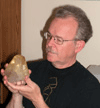
Joined: 29 Dec 2008
Posts: 846
Location: Northeast Ohio



|
 Posted: Oct 25, 2017 19:57 Post subject: Re: Rarest quartz twins with inclined axes C Posted: Oct 25, 2017 19:57 Post subject: Re: Rarest quartz twins with inclined axes C |
|
|
I have been watching this thread with interest, and with Josele's comments I am motivated to weigh in.
The classical model of contact twinning by growth is of two individuals which come into existence simultaneously or very nearly so, under conditions which permit such "mistakes" to persist but quickly cease to be favored as a crystal increases in size. This results in two (or sometimes several) individuals of nearly the same size related (usually) to each other by a relationship that can be expressed as a rational plane with simple Miller indices in the symmetry system of the mineral, usually a mirror operation.
Various experiments and observations demonstrate that another mode of oriented growth occurs in which one or more seeds of a second generation fall upon an existing crystal, and "skate around" to find an energetically favorable orientation. If this orientation is exact parallelism with the existing crystal's lattice, we may never recognize their existence. But other relatively low-energy orientations can be found and favored for further growth of the new individual.
In some minerals, some of these orientations correspond to those of classical twins. In others cases, they represent new orientations that can recur more frequently than random orientations (though observer bias has to be considered).
In quartz, a number of "exotic" laws have been proposed, as summarized in the third volume of Dana's System, 7th edition. Most of these are known only from "young on old" relationships such as are being illustrated in this thread. The well respected crystalographer Dr. Clifford Frondel, the author of this volume, reports these relationships but expresses skepticism about their validity.
In my view, the relationships described in this thread fail to meet the standard of description for classical twins (i.e. a twin plane or a twin operation relating subequal individuals). They are much more akin to the descriptions of epitactic relationships, in which a pair of planes are parallel and a pair of vectors in those planes are also parallel. Perhaps these "twins" should be considered examples of autoepitaxy (homoepitaxy) rather than classical twinning. If multiple examples of twins showing two subequal individuals related by the reported orientations can be found and rigorously documented, the case for calling them twins, at least in the classical sense, would be much stronger.
_________________
Collecting and studying crystals with interesting habits, twinning, and epitaxy |
|
| Back to top |
|
 |
Reef
Joined: 13 Dec 2016
Posts: 36


|
 Posted: Oct 26, 2017 08:10 Post subject: Re: Rarest quartz twins with inclined axes C Posted: Oct 26, 2017 08:10 Post subject: Re: Rarest quartz twins with inclined axes C |
|
|
Pete, thanks for the clarification.I did only visualization of these twinning laws. So far, nothing new has been proposed. In the literature there are only descriptions or mentions of these laws, and I have never seen drawings or photos. Therefore, most collectors and do not know what their appearance (especially in nature). I hope with the help of my schematic drawings the statistics of the finds will increase. The skepticism of K. Frondel is in my opinion connected with a small amount of finds.
In quartz, there are only two types of classical twinning: the Dauphine and the Brazilian. All other types are related to contact, regardless of the genesis and size of subindivids. Twinning is associated with the crystal lattice, and the appearance is secondary. The twinned part (common for subindivids) in such twins is usually a very thin layer at the place of contact (possibly atoms or molecules). Geometrically the correct habit is not found in nature. In the history of quartz mining (millions and millions of tons ...), there is no known finding with equal subindivids, except for Japanese twins. Although in any form of such finds is very small.
I can be mistaken, I'm just an amateur.
|
|
| Back to top |
|
 |
|





